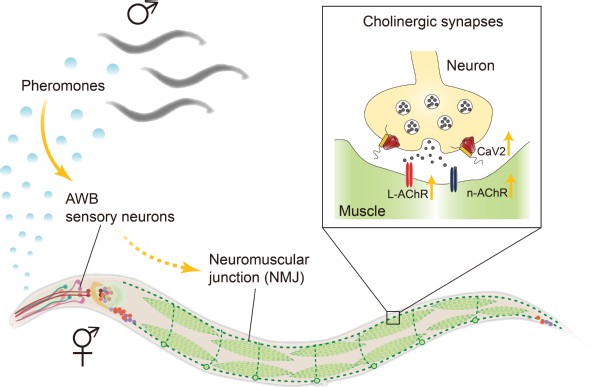Sad tears from a lady can inhibit sexual impulse of a man. Why and how? Clues can be found from a recent study led by Professor Tong Xiajing at SLST. She and colleagues published a research article in the journal eLife entitled, “Male pheromones modulate synaptic transmission at the C. elegans neuromuscular junction in a sexually dimorphic manner. This study reveals how the male pheromone environment modulates neurodevelopment and synaptic transmission in a sex-specific manner.
Environmental factors including pheromones are strong drivers to modulate behavior and alter physiology. Interestingly, pheromones often show sexually- dimorphic effects. In humans, the pheromone signal from male sweat affects female endocrine balance and increases the secretion of serotonin, the happiness factor. Newborn mice emit pheromone signals that promote parenting behaviors in virgin females but trigger aggressive responses in virgin males. In worms and fruit flies, the pheromones secreted by males attract females but repel males.
Tong’s group has observed an interesting phenomenon in the worm C. elegans. Hermaphrodites, but not male worms, developed under the male existing environment present significantly higher excitatory synaptic transmission at neuromuscular junctions (NMJ) than those from the hermaphrodite alone environment. High excitatory synaptic transmission decreases locomotion velocity and promotes mating efficiency.
The team further discovered that male-specific pheromones mediate the synaptic transmission modulation effect. By dissecting sensory circuits in the worm, they discovered that AWB chemosensory neurons (similar to olfactory neurons in human) sense those male pheromones and then transduce information to the NMJ. While the AWB neurons are shared by both sexes, the male pheromones only excite AWBs in the hermaphrodites, but not in the males.
These findings by Professor Tong and colleagues demonstrate a cellular and circuit mechanism for synaptic modulation and behavioral flexibility by sexual dimorphic pheromones. This work was supported by the Science and Technology Commission of Shanghai Municipality and National Natural Science Foundation of China.
Article link: https://elifesciences.org/articles/67170

Figure. Male-specific pheromones modulate hermaphrodite cholinergic transmission at the neuromuscular junction (NMJ)


